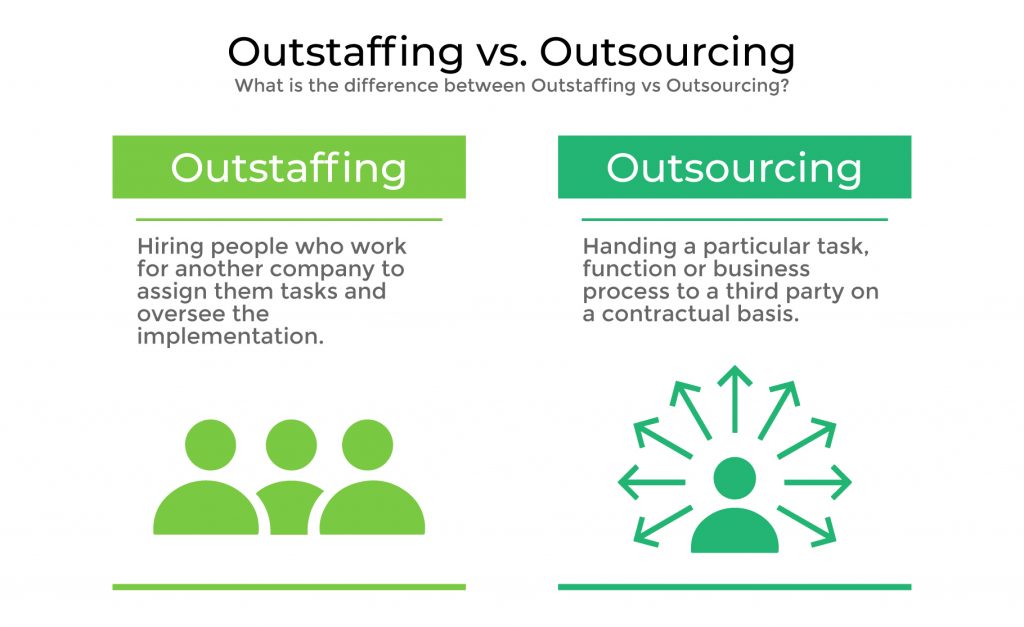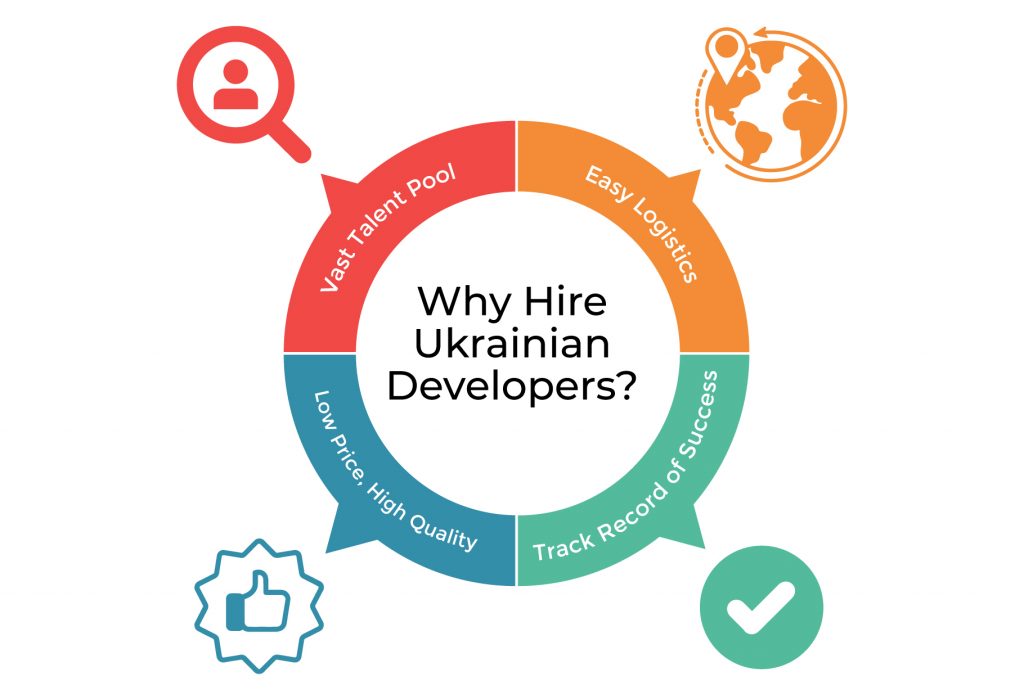As any software development manager knows, tech has become a fully globalized endeavor. Leveraging the outsourcing or outstaffing models to accomplish goals is the norm rather than the exception, and it’s rare to find a company of any size that doesn’t take advantage of the low price and high quality of offshore talent.
One of the best sources for outstaffing vendors is Ukraine, and has been for years. The country perfectly epitomizes the excellent cost/value proposition any manager is looking for, and working with a Ukrainian team is wonderfully convenient for much of the Western world.
If you’ve already begun the search for a qualified service partner, then read on for some tips on how to select the right vendor. And if you’re new to the concept of outstaffing in general, then start right here.
What Is Outstaffing
Although the term might be unfamiliar, the outstaffing model is a very old one.
From the perspective of a client, outstaffing isn’t much different than taking on a contractor. The difference is that the contractor has been carefully selected by an outstaffing supplier to be qualified for the job.
If you’ve ever worked with a temp agency, then you already have some familiarity with how outstaffing works.

In exchange for a flat, predictable, regular fee, you gain complete access to a qualified and vetted IT professional. As long as the outstaffing supplier is reputable, then you can rest assured that the worker’s skills are as advertised, saving you the long slog of hiring.
Because the worker is employed by the outstaffing supplier, not by you, you are not responsible for employment overhead like taxes, benefits, or HR issues. The worker is entirely under your control, and in most cases is dedicated solely to your enterprise.
On the downside, the proper management and use of the worker is up to you. The supplier won’t tell you how to best apply the worker’s skills to your individual project.
Therefore, IT outstaffing often works best for companies that already have some degree of in-house development capacity. An outstaffed worker doesn’t replace an entire IT department, they supplement it.
If you’re hoping to completely offload your development, then outsourcing is often the better path.
Outstaffing vs. Outsourcing
The difference between outstaffing and outsourcing are critical, but often misunderstood. It comes down to a fundamental distinction in the purpose of the endeavor.
Essentially, the purpose of outstaffing is to bring on a single worker who will join your team and function much as your other employees. The worker is under your direct management, and you are responsible for applying their skills to best suit your business goals. The relationship is open-ended, lasting for as long as you have a need, and can often transition into a direct hire of the worker.
The purpose of outsourcing, by contrast, is to complete one individual project. The outsourcing company acts as a “black box”. You feed it a specific goal, such as developing an app or building a website. The outsource vendor then uses its own internal resources (its own employees and contractors) to complete the task.

As the client, you are not necessarily involved in the day-to-day decision-making of achieving the goal. The outsourcing supplier typically has an entire team equivalent to an IT department working for you, but your only point of contact may be the project manager.
Outsourcing is much easier to manage, as the project can typically be completed without heavy involvement from your own personnel. The downside is that outsourcing is specced out and billed by the project. Once the project is complete, you may certainly hire the same outsourcing firm for a new one. However, they will typically need to start from square one, analyzing the project needs and providing a fresh quote for the work.
By contrast, outstaffing gains you complete access to a skilled worker who may be assigned and reassigned as you see fit. Just like a worker in your own office, you are free to ask them to focus on one project, bounce between several, or complete several projects in succession as you see fit, and all at the same rate.
With the difference between the two clear, it should be much easier to make a decision between the outsourcing and outstaffing models.
Selecting an Outstaffing Supplier
If outstaffing is right for you, then your next job is to select a supplier. This is a critical step that needs to be done right, since the supplier is the one who will source the talent you’ll be working with.
Interview several vendors, but before you do, gain a clear understanding of your own needs. If you’re not sure if you need a full-stack developer or one specialized in Java, a mobile app developer or a game design wizard, then you’re not doing yourself or the supplier any favors.
Understand what you’re looking for before you go searching for it, or at best you’ll waste time. At worst, you’ll end up with an outstaff worker who is unable to complete the tasks for which you brought them on.
Aside from the obvious questions like price (tip: going overseas is almost always cheaper), there are some things you should make sure to find out up front, before signing the contract.
- Do you have workers available who meet my specific needs? If not, how long will it take to hire them?
- How do you minimize churn and ensure workers stay on for the long haul? Do you provide benefits sufficient to keep them on board?
- Where will my workers be located? What hours will they be available for communication?
- Will the workers speak my language? Unlike in an outsourcing situation, it is critical that you are able to communicate directly with your outstaffed developers. If your office only speaks English, and the developer only speaks Hindi, it will clearly not work out.
- What is the process for hiring or dismissing workers from my outstaffed team? Are there additional fees for doing so?
- Do your workers have a preferred project management methodology, such as Scrum or Kanban?
Before you can ask these questions, of course, you need to find several candidate agencies to interview. If you’re looking to realize massive financial savings without sacrificing quality, then you’ll want to go overseas. But which country is best suited to outstaffing?
Outstaffing + Ukraine = Software Development Heaven
Although many people tend to think of India or the Philippines when considering outsourcing or outstaffing, the smartest companies turn to Ukraine first. Ukraine is a perfect fit for IT services in numerous ways, and the reasons to look into the Eastern European country only grow stronger with time.

1. Vast Talent Pool
Ukraine is quickly gaining a reputation as the tech capital of Eastern Europe. The country is home to 402 universities, with 40,000 students graduating each year. IT, engineering, and other STEM fields are hugely popular among young Ukrainians looking for financial stability, so many of those graduates hold degrees directly applicable to outstaffed development work.
In fact, 57% of IT specialists in Ukraine hold degrees directly applicable to their work.
2. Easy Logistics
Most of Ukraine, including the capital city of Kyiv where most IT firms are located, falls within the GMT +3 time zone. This is the same as Israel, and only an hour or two off from Western Europe. This makes scheduling calls and meetings relatively easy when working with a Ukrainian team.
Language, the bane of so many outsourcing and outstaffing relationships, is typically not an issue in Ukraine. Russian is commonly spoken across the country, and the vast majority of educated IT workers are fluent in English.
3. Track Record of Success
Ukraine is a major destination for global corporations looking for quality IT work, and the country’s success stories include Intel, Microsoft, Google, and many more. Many of the veterans of these corporate R&D labs go on to found or play key roles in new, disruptive ventures.
Grammarly, Petcube, Plarium, TemplateMonster, and many more of tech’s rising stars are either based in Ukraine, or make heavy use of Ukrainian dev talent.
4. Low Price, High Quality
Despite the abundance of educated, skilled, experienced workers, Ukrainian outstaffing typically costs far less than equivalent services in the Western world. A senior software engineer, for example, earns on average $39,600 USD per year. In the US, the same position costs an average of $107,580 to fill.
The cost of living and the expected wages are simply much lower in Ukraine, and offshore companies can leverage this to save vast sums of money without sacrificing quality or convenience.
The Right Model for the Right Project
The question of outstaffing vs outsourcing isn’t complicated, once you are armed with enough information to make a decision. I hope that this guide clarified things, and that if you should decide the outstaffing model is right for your needs, that you feel well-equipped to locate vendors and choose between them.
Like any shift in business practices, bringing on an outstaffing agency shouldn’t be taken lightly. Carefully interview your candidates, ensure that they understand your needs, and ensure that the worker or team they provide is the right one for you. Taking the time to do so up front will allow you to save money, improve productivity, and vastly boost your IT output.
